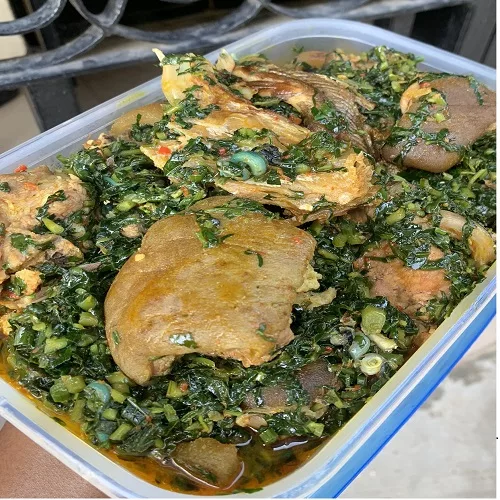
Are you living with diabetes and craving the delicious flavors of Nigerian cuisine? We’ve got great news for you! In this article, we’ll explore 20 delectable Nigerian dishes that are not only sugar-free but also ideal for maintaining a healthy lifestyle while managing diabetes.
1. Efo Riro:
A Nutrient-Rich Nigerian Vegetable Soup
Efo Riro is a popular Nigerian soup, particularly in the Yoruba culture, known for its rich and flavorful combination of vegetables, meats, and fish. What sets Efo Riro apart is its vibrant green color, a result of the leafy vegetables used in its preparation. The name “Efo Riro” translates to “stirred vegetable” in Yoruba, which perfectly describes the process of making this delectable dish.
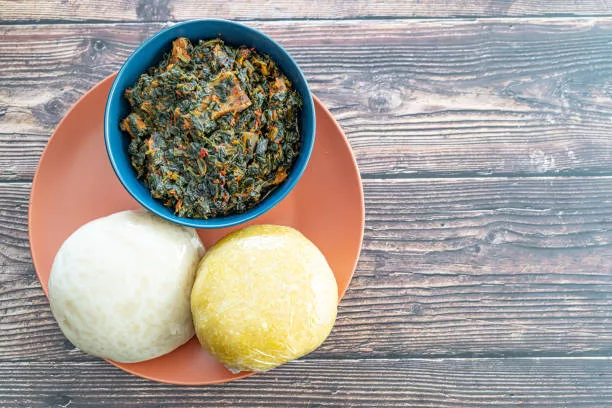
Ingredients:
- Fluted pumpkin leaves (ugu leaves) or spinach
- Assorted meats or fish (such as beef, goat meat, cow tripe, or fish)
- Palm oil
- Ground crayfish
- Onions
- Fresh tomatoes or tomato paste
- Red bell peppers
- Scotch bonnet peppers (for a spicy kick)
- Seasonings and spices (like stock cubes, salt, and black pepper)
Preparation:
- Prepare the Meat or Fish: Begin by cooking your choice of meats or fish until they are tender and flavorful. This often involves boiling with onions, salt, and stock cubes.
- Blanch the Vegetables: If you’re using fluted pumpkin leaves, blanch them in hot water to soften them. If you’re using spinach, you can skip this step.
- Prepare the Sauce: In a separate pot, heat palm oil until it becomes clear. Be careful not to overheat it, as palm oil can become bitter. Add chopped onions and let them sauté for a few minutes.
- Blend the Pepper Mix: In a blender, combine fresh tomatoes, red bell peppers, and Scotch bonnet peppers. Blend until you have a smooth paste.
- Cook the Pepper Mix: Add the blended pepper mix to the palm oil and onions. Let it simmer and cook down until the oil starts to separate from the pepper, and the mixture thickens.
- Add Seasonings: Season the pepper mix with ground crayfish, stock cubes, and salt according to your taste.
- Incorporate the Meat or Fish: Add the cooked meats or fish to the pot with the pepper mix. Stir well to ensure they are coated with a flavorful sauce.
- Add the Vegetables: Now, it’s time to incorporate the blanched fluted pumpkin leaves or spinach. Stir them into the pot and let them cook for a few minutes.
- Simmer and Serve: Let the entire mixture simmer for a short while, allowing all the flavors to meld together. Serve your Efo Riro hot with a side of your choice, often enjoyed with rice, pounded yam, or eba.
Efo Riro is not only a treat for the taste buds but also a healthy option, especially when you use lean meats and manage the amount of palm oil. This dish is rich in essential nutrients from the vegetables and proteins from the meat or fish, making it a great addition to a diabetic-friendly menu. Just be mindful of portion sizes to keep your carbohydrate intake in check. Enjoy this Nigerian classic!
2. Okro Soup:
A Diabetes-Friendly Nigerian Delicacy
Okro Soup, also known as Okra Soup, is a beloved Nigerian dish that is not only delicious but also suitable for individuals managing diabetes. This slimy soup is made from okra, a vegetable that is naturally low in sugar and rich in nutrients.

Ingredients:
- Fresh okra
- Assorted meats or fish (common choices include beef, goat meat, or fish)
- Palm oil
- Onions
- Ground crayfish
- Fresh tomatoes or tomato paste
- Red bell peppers
- Scotch bonnet peppers (for those who like it spicy)
- Seasonings and spices (such as stock cubes, salt, and black pepper)
Preparation:
- Prepare the Meat or Fish: Start by cooking your choice of meats or fish until they are tender and flavorful. This usually involves boiling with onions, salt, and stock cubes.
- Wash and Chop the Okra: Rinse the fresh okra thoroughly and trim off the tops and tails. Then, finely chop or slice the okra into small rounds.
- Prepare the Sauce: In a separate pot, heat palm oil until it becomes clear but not overheated. Add chopped onions and let them sauté for a few minutes.
- Blend the Pepper Mix: In a blender, combine fresh tomatoes, red bell peppers, and Scotch bonnet peppers. Blend until you have a smooth paste.
- Cook the Pepper Mix: Add the blended pepper mix to the palm oil and onions. Let it simmer and cook down until the oil starts to separate from the pepper, and the mixture thickens.
- Add Seasonings: Season the pepper mix with ground crayfish, stock cubes, salt, and black pepper to taste.
- Incorporate the Meat or Fish: Add the cooked meats or fish to the pot with the pepper mix. Stir well to ensure they are coated with a flavorful sauce.
- Add the Chopped Okra: Gently add the chopped okra to the pot and stir well. Cook for a few minutes, ensuring the okra doesn’t become too slimy.
- Simmer and Serve: Let the mixture simmer for a short while, allowing all the flavors to blend together. Serve your Okro Soup hot, often enjoyed with fufu, pounded yam, or amala.
Health Benefits for Diabetics:
Okro Soup offers several health benefits for individuals managing diabetes:
- Low Sugar Content: Okra is naturally low in sugar, making it an excellent choice for those looking to control their blood sugar levels.
- High in Fiber: Okra is rich in dietary fiber, which can help regulate blood sugar and promote digestive health.
- Nutrient-Rich: The addition of lean meats or fish, along with vegetables, provides essential nutrients, vitamins, and protein.
Remember to be mindful of portion sizes, as carbohydrates can affect blood sugar levels. Okro Soup, when prepared without excessive palm oil and paired with balanced portions of fufu or other accompaniments, can be a delicious and diabetes-friendly addition to your Nigerian culinary journey. Enjoy the satisfying flavors while prioritizing your health.
3. Edikang Ikong Soup:
A Nutrient-Packed Nigerian Delight
Edikang Ikong Soup is a traditional Nigerian dish, especially popular among the Efik and Ibibio people. It’s renowned for its rich combination of nutrient-dense leafy vegetables and protein sources, making it a satisfying and diabetes-friendly choice.

Ingredients:
- Fluted pumpkin leaves (ugu leaves)
- Waterleaf
- Assorted meats or fish (common choices include cow tripe, goat meat, or fish)
- Palm oil
- Ground crayfish
- Onions
- Fresh tomatoes or tomato paste
- Red bell peppers
- Scotch bonnet peppers (for those who enjoy some heat)
- Seasonings and spices (such as stock cubes, salt, and black pepper)
Preparation:
- Prepare the Meat or Fish: Begin by cooking your choice of meats or fish until they are tender and flavorful. This typically involves boiling with onions, salt, and stock cubes.
- Wash and Chop the Vegetables: Rinse the fluted pumpkin leaves and waterleaf thoroughly. Chop them into thin strips or slices.
- Prepare the Sauce: In a separate pot, heat palm oil until it becomes clear but not overheated. Add chopped onions and let them sauté for a few minutes.
- Blend the Pepper Mix: In a blender, combine fresh tomatoes, red bell peppers, and Scotch bonnet peppers. Blend until you have a smooth paste.
- Cook the Pepper Mix: Add the blended pepper mix to the pot with the palm oil and onions. Let it simmer and cook down until the oil starts to separate from the pepper, and the mixture thickens.
- Add Seasonings: Season the pepper mix with ground crayfish, stock cubes, salt, and black pepper to taste.
- Incorporate the Meat or Fish: Add the cooked meats or fish to the pot with the pepper mix. Stir well to ensure they are coated with a flavorful sauce.
- Add the Chopped Vegetables: Gently add the chopped fluted pumpkin leaves and waterleaf to the pot. Stir them into the sauce and let them cook for a few minutes, allowing the flavors to meld together.
- Simmer and Serve: Let the mixture simmer for a short while to ensure that all the ingredients are well combined. Edikang Ikong Soup is typically served hot and enjoyed with a variety of Nigerian staples, such as fufu, pounded yam, or eba.
Health Benefits for Diabetics:
Edikang Ikong Soup offers several health benefits for individuals managing diabetes:
- Low Sugar Content: The primary ingredients in this soup, fluted pumpkin leaves, and waterleaf, are naturally low in sugar, making it a suitable choice for diabetes management.
- High in Fiber: The vegetables in Edikang Ikong Soup are rich in dietary fiber, which can help regulate blood sugar levels and support digestive health.
- Nutrient-Rich: The inclusion of lean meats or fish, along with vegetables, provides essential nutrients, vitamins, and protein.
As with all dishes, portion control is essential to manage carbohydrate intake. Edikang Ikong Soup is a delightful way to savor the flavors of Nigeria while prioritizing your health. Enjoy this diabetes-friendly dish as part of your balanced diet and journey towards well-being.
4. Vegetable Stir-Fry:
A Wholesome and Diabetes-Friendly Delight
Vegetable Stir-Fry is a flexible and healthy dish that can be enjoyed by individuals managing diabetes. This savory and colorful creation combines a variety of fresh vegetables stir-fried to perfection, resulting in a delicious and nutrient-packed meal.

Ingredients:
- A mix of fresh vegetables (common choices include bell peppers, broccoli, carrots, snap peas, mushrooms, and baby corn)
- Lean protein (such as chicken, tofu, or shrimp)
- Low-sodium soy sauce or tamari
- Fresh garlic and ginger
- Cooking oil (like canola or sesame oil)
- Optional seasonings and spices (e.g., crushed red pepper flakes or sesame seeds)
- Brown rice or cauliflower rice (for serving, optional)
Preparation:
- Prepare the Ingredients: Wash and chop your selected vegetables into bite-sized pieces. If using protein (chicken, tofu, shrimp, etc.), cut it into small strips or cubes.
- Prepare the Sauce: In a small bowl, mix low-sodium soy sauce or tamari with freshly minced garlic and ginger. This sauce will add depth of flavor to your stir-fry.
- Stir-Fry the Protein: In a large skillet or wok, heat a small amount of cooking oil over medium-high heat. If you’re using protein, stir-fry it first until it’s fully cooked and set it aside.
- Stir-Fry the Vegetables: In the same skillet or wok, add a bit more oil if needed and then stir-fry your vegetables. Start with the denser ones like carrots and broccoli, and gradually add the rest. Cook until they’re tender yet still crisp.
- Recombine the Protein: Return the cooked protein to the skillet with the vegetables and combine them.
- Add the Sauce: Pour your prepared sauce over the stir-fry and stir to evenly coat all the ingredients. Cook for a few more minutes to allow the flavors to meld.
- Optional Garnishes: If desired, add crushed red pepper flakes or sesame seeds for a touch of heat or extra flavor.
- Serve Hot: Your Vegetable Stir-Fry can be served hot over a bed of brown rice or cauliflower rice for a satisfying and well-rounded meal.
Health Benefits for Diabetics:
Vegetable Stir-Fry offers numerous advantages for individuals managing diabetes:
- Low in Sugar: Vegetables are naturally low in sugar, making this dish diabetes-friendly.
- High in Fiber: The mix of vegetables in a stir-fry provides dietary fiber, which can help control blood sugar levels and improve digestion.
- Balanced Nutrition: With the addition of lean protein, you get a well-balanced meal that includes essential nutrients, vitamins, and minerals.
- Control Over Ingredients: When you prepare your own stir-fry, you have full control over the ingredients, making it easy to customize for your dietary needs.
Vegetable Stir-Fry is a quick and delightful way to incorporate a variety of vegetables into your diet while keeping blood sugar levels in check. It’s a versatile dish that can be adapted to your preferences and dietary requirements, making it a wonderful choice for individuals with diabetes looking for delicious and wholesome meals.
5. Bitter Leaf Soup:
A Unique and Diabetes-Friendly Nigerian Classic
Bitter Leaf Soup, also known as “Ofe Onugbu” in Igbo, is a traditional Nigerian delicacy with a distinctive flavor. It’s made from bitter leaves (African or bitter leaf) and is a favored choice among various Nigerian ethnic groups. Despite its name, Bitter Leaf Soup offers a range of health benefits and is a diabetes-friendly option when prepared thoughtfully.

Ingredients:
- Bitter leaves (African or bitter leaf)
- Assorted meats or fish (common options include goat meat, cow tripe, or fish)
- Palm oil
- Onions
- Ground crayfish
- Fresh tomatoes or tomato paste
- Red bell peppers
- Scotch bonnet peppers (for those who prefer a bit of heat)
- Seasonings and spices (e.g., stock cubes, salt, and black pepper)
Preparation:
- Prepare the Meat or Fish: Start by cooking your choice of meats or fish until they’re tender and flavorful. This typically involves boiling them with onions, salt, and stock cubes.
- Wash the Bitter Leaves: Bitter leaves, as the name suggests, are naturally bitter. To reduce the bitterness, wash the leaves thoroughly. You can soak them in water, change the water a few times, or use a technique known as “leaching” by parboiling them briefly. This step is crucial to make the dish more palatable.
- Prepare the Sauce: In a separate pot, heat palm oil until it becomes clear. Add chopped onions and allow them to sauté for a few minutes.
- Blend the Pepper Mix: In a blender, combine fresh tomatoes, red bell peppers, and Scotch bonnet peppers. Blend until you have a smooth paste.
- Cook the Pepper Mix: Add the blended pepper mix to the palm oil and onions. Let it simmer and cook down until the oil starts to separate from the pepper, and the mixture thickens.
- Season the Sauce: Season the pepper mix with ground crayfish, stock cubes, salt, and black pepper to your taste.
- Incorporate the Meat or Fish: Add the cooked meats or fish to the pot with the pepper mix. Stir well to ensure they are coated with a flavorful sauce.
- Add the Bitter Leaves: Gently add the washed and prepared bitter leaves to the pot. Stir them into the sauce and let them cook for a few minutes to meld with the other ingredients.
- Simmer and Serve: Let the mixture simmer for a short while to allow all the flavors to meld together. Bitter Leaf Soup is typically served hot and enjoyed with Nigerian staples such as fufu, pounded yam, or eba.
Health Benefits for Diabetics:
Bitter Leaf Soup offers certain health benefits for individuals managing diabetes:
- Low Sugar Content: The primary ingredient, bitter leaves, is naturally low in sugar, making it a suitable choice for diabetes management.
- High in Fiber: Bitter leaves provide dietary fiber, which can help regulate blood sugar levels and promote digestive health.
- Balanced Nutrition: With the inclusion of lean meats or fish, Bitter Leaf Soup offers a balanced meal rich in nutrients, vitamins, and protein.
While Bitter Leaf Soup may be an acquired taste due to its bitterness, many people find it enjoyable when prepared correctly. By following these steps and being mindful of portion sizes, you can savor this distinctive Nigerian classic while managing diabetes and enjoying its health benefits.
6. Egusi Soup (Without Added Sugar):
A Delicious and Diabetes-Friendly Nigerian Option
Egusi Soup, made without added sugar, is a well-loved and versatile Nigerian soup that’s both delicious and suitable for individuals managing diabetes. It’s renowned for its rich and nutty flavor, derived from ground melon seeds, and is a staple in many Nigerian households.
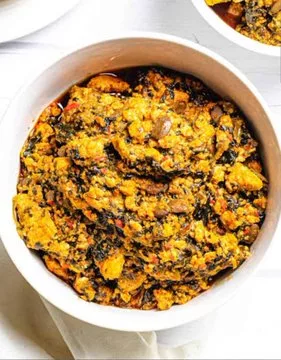
Ingredients:
- Egusi (ground melon seeds)
- Assorted meats or fish (common options include beef, goat meat, cow tripe, or fish)
- Palm oil
- Onions
- Ground crayfish
- Fresh tomatoes or tomato paste
- Red bell peppers
- Scotch bonnet peppers (for those who enjoy some heat)
- Leafy vegetables (fluted pumpkin leaves or spinach)
- Seasonings and spices (e.g., stock cubes, salt, and black pepper)
Preparation:
- Prepare the Meat or Fish: Start by cooking your choice of meats or fish until they are tender and flavorful. This typically involves boiling with onions, salt, and stock cubes.
- Make the Egusi Paste: In a separate bowl, mix the ground egusi with some water to form a smooth, thick paste. Set this aside.
- Prepare the Sauce: In a large pot, heat palm oil until it becomes clear but not overheated. Add chopped onions and allow them to sauté for a few minutes.
- Blend the Pepper Mix: In a blender, combine fresh tomatoes, red bell peppers, and Scotch bonnet peppers. Blend until you have a smooth paste.
- Cook the Pepper Mix: Add the blended pepper mix to the pot with the palm oil and onions. Let it simmer and cook down until the oil starts to separate from the pepper, and the mixture thickens.
- Add Seasonings: Season the pepper mix with ground crayfish, stock cubes, salt, and black pepper to taste.
- Incorporate the Egusi Paste: Gently add the prepared Egusi paste to the pot, stirring it into the sauce to form a thick, creamy mixture.
- Add the Meat or Fish: Add the cooked meats or fish to the pot with the egusi mixture. Stir well to ensure they are coated with a flavorful sauce.
- Incorporate the Leafy Vegetables: Gently add the fluted pumpkin leaves or spinach to the pot. Stir them into the soup and let them cook for a few minutes to meld with the other ingredients.
- Simmer and Serve: Allow the soup to simmer for a short while, ensuring all the flavors meld together. Egusi Soup is typically served hot and is often enjoyed with a side of pounded yam, fufu, or eba.
Health Benefits for Diabetics:
Egusi Soup made without added sugar offers several health benefits for individuals managing diabetes:
- Low Sugar Content: Egusi seeds themselves are naturally low in sugar, making them a suitable choice for diabetes management.
- Rich in Protein: The addition of meats or fish in Egusi Soup provides protein, which is essential for a well-balanced diet.
- High in Fiber: The inclusion of leafy vegetables and egusi seeds adds dietary fiber, which can help regulate blood sugar levels and support digestive health.
When prepared thoughtfully and enjoyed in moderation, Egusi Soup without added sugar can be a delightful part of a diabetes-friendly menu. Savor its nutty richness and the combination of flavors while maintaining control over your blood sugar levels.
7. Oha Soup:
A Nutrient-Rich and Diabetes-Friendly Nigerian Delight
Oha Soup is a classic and much-admired Nigerian soup, especially among the Igbo people. This delectable dish is celebrated for its unique flavor, which comes from the use of Oha leaves (Ora leaves) and a blend of meats or fish. Oha Soup is not only delicious but also a diabetes-friendly option when prepared thoughtfully.
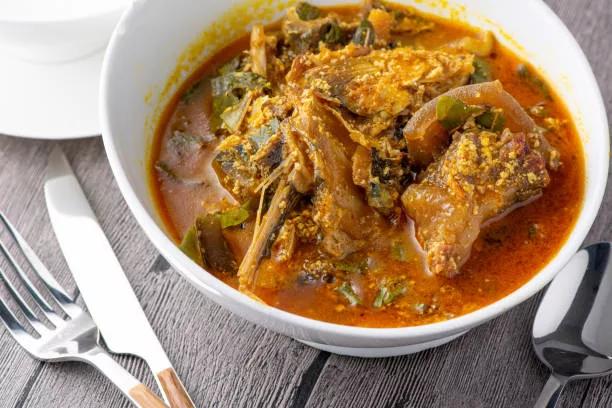
Ingredients:
- Oha leaves (Ora leaves)
- Assorted meats or fish (common choices include goat meat, cow tripe, or fish)
- Palm oil
- Onions
- Ground crayfish
- Fresh tomatoes or tomato paste
- Red bell peppers
- Scotch bonnet peppers (for those who enjoy some heat)
- Cocoyam or achi thickener (optional)
- Seasonings and spices (e.g., stock cubes, salt, and black pepper)
Preparation:
- Prepare the Meat or Fish: Start by cooking your choice of meats or fish until they are tender and flavorful. This typically involves boiling with onions, salt, and stock cubes.
- Wash and Slice the Oha Leaves: Rinse the Oha leaves thoroughly and then slice them into thin strips. The leaves are added towards the end of the cooking process to maintain their freshness and flavor.
- Prepare the Sauce: In a separate pot, heat palm oil until it becomes clear but not overheated. Add chopped onions and let them sauté for a few minutes.
- Blend the Pepper Mix: In a blender, combine fresh tomatoes, red bell peppers, and Scotch bonnet peppers. Blend until you have a smooth paste.
- Cook the Pepper Mix: Add the blended pepper mix to the pot with the palm oil and onions. Let it simmer and cook down until the oil starts to separate from the pepper, and the mixture thickens.
- Add Seasonings: Season the pepper mix with ground crayfish, stock cubes, salt, and black pepper to taste.
- Incorporate the Meat or Fish: Add the cooked meats or fish to the pot with the pepper mix. Stir well to ensure they are coated with a flavorful sauce.
- Thicken the Soup (Optional): If desired, you can thicken the soup using cocoyam or achi thickener. Blend either of these with a bit of water and add it to the soup, stirring well.
- Incorporate the Oha Leaves: Gently add the sliced Oha leaves to the pot. Stir them into the soup and let them cook for a few minutes to meld with the other ingredients.
- Simmer and Serve: Let the soup simmer for a short while to ensure all the flavors meld together. Oha Soup is typically served hot and is often enjoyed with fufu, pounded yam, or eba.
Health Benefits for Diabetics:
Oha Soup offers certain health benefits for individuals managing diabetes:
- Low Sugar Content: Oha leaves are naturally low in sugar, making this soup diabetes-friendly.
- Rich in Fiber: The inclusion of Oha leaves adds dietary fiber, which can help regulate blood sugar levels and promote digestive health.
- Balanced Nutrition: With the addition of lean meats or fish, Oha Soup provides a well-balanced meal rich in nutrients, vitamins, and protein.
Oha Soup is a delightful way to savor the flavors of Nigeria while keeping blood sugar levels in check. When prepared without excessive palm oil and served in moderation, it can be a delicious and diabetes-friendly part of your culinary journey. Enjoy its unique and satisfying taste while prioritizing your health.
8. Afang Soup:
A Nutrient-Packed and Diabetes-Friendly Nigerian Classic
Afang Soup is a highly nutritious and delicious Nigerian dish, particularly popular in the Efik and Ibibio communities of Nigeria. It’s celebrated for its unique flavor, achieved through the combination of wild leaves and a variety of meats or fish. Afang Soup is not only a delightful culinary experience but also a diabetes-friendly option when prepared carefully.
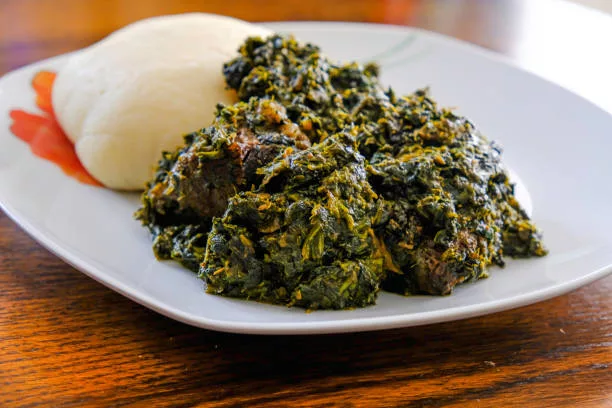
Ingredients:
- Wild leaves (commonly Afang leaves or Okazi leaves)
- Assorted meats or fish (choices include beef, goat meat, cow tripe, or fish)
- Palm oil
- Onions
- Ground crayfish
- Fresh tomatoes or tomato paste
- Red bell peppers
- Scotch bonnet peppers (for those who enjoy some heat)
- Cocoyam or achi thickener (optional)
- Seasonings and spices (e.g., stock cubes, salt, and black pepper)
Preparation:
- Prepare the Meat or Fish: Start by cooking your choice of meats or fish until they are tender and flavorful. This typically involves boiling with onions, salt, and stock cubes.
- Wash and Slice the Wild Leaves: Rinse the wild leaves (Afang or Okazi leaves) thoroughly, and then slice them into thin strips. These leaves are the hallmark of Afang Soup and should be prepared with care.
- Prepare the Sauce: In a separate pot, heat palm oil until it becomes clear but not overheated. Add chopped onions and allow them to sauté for a few minutes.
- Blend the Pepper Mix: In a blender, combine fresh tomatoes, red bell peppers, and Scotch bonnet peppers. Blend until you have a smooth paste.
- Cook the Pepper Mix: Add the blended pepper mix to the pot with the palm oil and onions. Let it simmer and cook down until the oil starts to separate from the pepper, and the mixture thickens.
- Add Seasonings: Season the pepper mix with ground crayfish, stock cubes, salt, and black pepper to taste.
- Incorporate the Meat or Fish: Add the cooked meats or fish to the pot with the pepper mix. Stir well to ensure they are coated with a flavorful sauce.
- Thicken the Soup (Optional): If desired, you can thicken the soup using cocoyam or achi thickener. Blend either of these with a bit of water and add it to the soup, stirring well.
- Incorporate the Sliced Wild Leaves: Gently add the sliced Afang or Okazi leaves to the pot. Stir them into the soup and let them cook for a few minutes to meld with the other ingredients.
- Simmer and Serve: Let the soup simmer for a short while to ensure all the flavors meld together. Afang Soup is typically served hot and is often enjoyed with fufu, pounded yam, or eba.
Health Benefits for Diabetics:
Afang Soup offers numerous health benefits for individuals managing diabetes:
- Low Sugar Content: The key ingredients, wild leaves, are naturally low in sugar, making this soup suitable for diabetes management.
- Rich in Fiber: The inclusion of wild leaves adds dietary fiber, which can help regulate blood sugar levels and support digestive health.
- Balanced Nutrition: With the addition of lean meats or fish, Afang Soup provides essential nutrients, vitamins, and protein.
Afang Soup is a fantastic way to enjoy the flavors of Nigeria while keeping your blood sugar levels in check. When prepared thoughtfully and enjoyed in moderation, it can be a satisfying and diabetes-friendly part of your culinary journey. Relish its unique taste and prioritize your health.
9. Coconut Rice:
A Flavorful and Diabetes-Friendly Nigerian Delight
Coconut Rice is a beloved Nigerian dish that’s both delicious and suitable for individuals managing diabetes. This flavorful and aromatic rice dish is prepared with coconut milk, giving it a creamy texture and a hint of tropical sweetness.

Ingredients:
- Long-grain white rice
- Coconut milk
- Assorted vegetables (common choices include carrots, peas, and green beans)
- Chicken or shrimp (optional)
- Onions
- Garlic and ginger
- Cooking oil
- Seasonings and spices (such as curry powder, thyme, bay leaves, and stock cubes)
- Fresh chili peppers (optional, for some heat)
- Green bell peppers (for garnish)
Preparation:
- Prepare the Rice: Rinse the rice thoroughly until the water runs clear. Drain and set it aside.
- Sauté the Aromatics: In a large pot, heat some cooking oil and sauté chopped onions, garlic, ginger, and fresh chili peppers (if using) until fragrant.
- Add the Rice: Stir in the drained rice and cook for a few minutes, allowing it to absorb the flavors.
- Add the Vegetables and Meat (Optional): If you’re using chicken or shrimp, add them to the pot along with the vegetables. Stir well to combine.
- Season the Mixture: Season the rice and vegetable mixture with curry powder, thyme, bay leaves, stock cubes, and salt. Adjust the seasonings to your taste.
- Pour in the Coconut Milk: Add the coconut milk to the pot, making sure it covers the rice and ingredients. If needed, add some water to ensure the rice is fully submerged.
- Simmer and Cook: Cover the pot and let the mixture simmer on low heat. Stir occasionally to prevent sticking. Cook until the rice is tender and has absorbed the coconut milk.
- Garnish and Serve: Garnish the Coconut Rice with sliced green bell peppers for a pop of color. Serve it hot.
Health Benefits for Diabetics:
Coconut Rice offers certain health benefits for individuals managing diabetes:
- Controlled Sugar Content: While coconut milk adds a touch of natural sweetness, it’s not overly high in sugar. The key is to monitor portion sizes to maintain blood sugar levels.
- Fiber from Vegetables: The vegetables included in Coconut Rice contribute dietary fiber, which can help regulate blood sugar levels and improve digestion.
- Balanced Nutrition: The addition of lean meats or shrimp provides essential nutrients and protein for a well-rounded meal.
When prepared thoughtfully and enjoyed in moderation, Coconut Rice can be a delightful part of a diabetes-friendly menu. The natural sweetness from coconut milk adds a tropical touch to this classic dish while still prioritizing your health.
10. Moi Moi:
A Protein-Packed and Diabetes-Friendly Nigerian Delight
Moi Moi, a steamed bean pudding, is a well-loved Nigerian dish that’s not only delicious but also suitable for individuals managing diabetes. This dish is made from ground peeled beans and a variety of seasonings, offering a substantial amount of protein and essential nutrients.

Ingredients:
- Peeled and ground black-eyed beans
- Red palm oil
- Onions
- Fresh pepper (Scotch bonnet or habanero, depending on spice preference)
- Bell peppers (red and green)
- Tomatoes (optional)
- Seasonings and spices (e.g., stock cubes, salt, and thyme)
- Eggs (optional)
- Vegetables (spinach, kale, or ugu leaves)
- Fish or shrimp (optional)
Preparation:
- Prepare the Beans: Start by soaking the peeled and ground black-eyed beans in water for a few hours or overnight. This softens the beans and makes them easier to blend.
- Blend the Beans: Drain the soaked beans and blend them with fresh pepper, onions, and a bit of red palm oil to create a smooth and thick batter. You can also add optional ingredients like tomatoes for added flavor.
- Season the Mixture: Season the batter with stock cubes, salt, thyme, and any other desired seasonings. Adjust the seasonings according to your taste.
- Add Vegetables and Protein (Optional): Fold in chopped bell peppers, vegetables (such as spinach, kale, or ugu leaves), and optional protein sources like fish or shrimp.
- Grease the Moi Moi Containers: Moi Moi is traditionally steamed in containers, such as foil or banana leaves. Grease the containers with red palm oil to prevent sticking.
- Fill the Containers: Fill the greased containers with the Moi Moi mixture. You can also add a whole boiled egg into each container for a delightful surprise.
- Steam the Moi Moi: Place the containers in a steamer or a large pot with a steaming rack. Steam the Moi Moi for about 45 minutes to 1 hour, depending on the size of the containers.
- Check for Doneness: To check if the Moi Moi is done, insert a toothpick or fork into the center. If it comes out clean, the Moi Moi is ready.
- Serve Hot: Allow the Moi Moi to cool slightly before serving. It can be enjoyed on its own or as a side dish with rice or other Nigerian staples.
Health Benefits for Diabetics:
Moi Moi offers numerous health benefits for individuals managing diabetes:
- High in Protein: Moi Moi is rich in protein, which can help maintain muscle mass and regulate blood sugar levels.
- Fiber from Vegetables: The addition of vegetables contributes to dietary fiber, which can support digestion and blood sugar control.
- Balanced Nutrition: Moi Moi provides essential nutrients, vitamins, and minerals, making it a well-rounded and satisfying meal.
When prepared thoughtfully and served in moderation, Moi Moi can be a delicious and diabetes-friendly addition to your Nigerian culinary experience. Its protein-rich content and versatility make it a versatile and nutritious choice for those looking to prioritize their health while enjoying the flavors of Nigeria.
11. Grilled Fish:
A Delicious and Diabetes-Friendly Nigerian Option
Grilled Fish is a popular Nigerian dish known for its simplicity and delightful flavors. It’s a healthy choice for individuals managing diabetes as it’s low in carbohydrates, high in protein, and offers a variety of essential nutrients.

Ingredients:
- Whole fresh fish (common choices include tilapia, catfish, or mackerel)
- Marinade (ingredients may include garlic, ginger, red pepper flakes, lemon juice, and your choice of herbs and spices)
- Cooking oil (such as vegetable oil)
- Seasonings (e.g., salt and black pepper)
Preparation:
- Prepare the Fish: Start by cleaning and gutting the whole fish. You can also request your fishmonger to do this for you.
- Marinate the Fish: In a bowl, prepare a marinade using ingredients like garlic, ginger, red pepper flakes, lemon juice, and your choice of herbs and spices. This marinade adds flavor to the fish and helps keep it moist during grilling.
- Score the Fish: Make a few shallow cuts on both sides of the fish. This will help the marinade penetrate and ensure even cooking.
- Marinate the Fish: Rub the marinade all over the fish, making sure to get it into the cuts you made. Let the fish marinate for at least 30 minutes, allowing the flavors to infuse.
- Preheat the Grill: Preheat your grill to medium-high heat. Ensure the grill grates are clean and lightly oiled to prevent sticking.
- Grill the Fish: Place the marinated fish on the grill and cook for about 5-7 minutes on each side, depending on the size and thickness of the fish. The fish is done when it flakes easily with a fork and has a nice, smoky flavor.
- Season to Taste: While grilling, you can season the fish with a pinch of salt and black pepper to enhance the taste.
- Serve Hot: Grilled Fish is typically served hot and can be accompanied by a side of vegetables, a fresh salad, or a diabetic-friendly sauce.
Health Benefits for Diabetics:
Grilled Fish offers various health benefits for individuals managing diabetes:
- High in Protein: Fish is a fantastic source of lean protein, which can help regulate blood sugar levels and promote satiety.
- Low in Carbohydrates: Grilled fish is naturally low in carbohydrates, making it an excellent choice for diabetes management.
- Essential Nutrients: Fish is rich in essential nutrients such as omega-3 fatty acids, which can benefit heart health, and various vitamins and minerals.
Grilled Fish is a delectable and diabetes-friendly choice that can be enjoyed as part of a well-balanced diet. Its simplicity, low-carb nature, and high protein content make it an excellent option for those looking to maintain control over their blood sugar levels while relishing the flavors of Nigeria.
12. Grilled Chicken:
A Delicious and Diabetes-Friendly Nigerian Delight
Grilled Chicken is a popular Nigerian dish known for its simplicity and delightful flavors. It’s a healthy choice for individuals managing diabetes as it’s low in carbohydrates, high in protein, and offers a variety of essential nutrients.

Ingredients:
- Chicken pieces (common choices include chicken breasts, drumsticks, or thighs)
- Marinade (ingredients may include garlic, ginger, red pepper flakes, lemon juice, and your choice of herbs and spices)
- Cooking oil (such as vegetable oil)
- Seasonings (e.g., salt and black pepper)
Preparation:
- Prepare the Chicken: Start by cleaning and trimming the chicken pieces. You can use bone-in or boneless chicken, depending on your preference.
- Marinate the Chicken: In a bowl, prepare a marinade using ingredients like garlic, ginger, red pepper flakes, lemon juice, and your choice of herbs and spices. This marinade adds flavor to the chicken and helps keep it moist during grilling.
- Marinate the Chicken: Rub the marinade all over the chicken pieces, making sure to coat them evenly. Let the chicken marinate for at least 30 minutes, allowing the flavors to infuse.
- Preheat the Grill: Preheat your grill to medium-high heat. Ensure the grill grates are clean and lightly oiled to prevent sticking.
- Grill the Chicken: Place the marinated chicken pieces on the grill and cook for about 5-7 minutes on each side, depending on the size and thickness of the pieces. The chicken is done when it reaches an internal temperature of 165°F (74°C) and has beautiful grill marks.
- Season to Taste: While grilling, you can season the chicken with a pinch of salt and black pepper to enhance the taste.
- Serve Hot: Grilled Chicken is typically served hot and can be accompanied by a side of vegetables, a fresh salad, or a diabetic-friendly sauce.
Health Benefits for Diabetics:
Grilled Chicken offers various health benefits for individuals managing diabetes:
- High in Protein: Chicken is a fantastic source of lean protein, which can help regulate blood sugar levels and promote satiety.
- Low in Carbohydrates: Grilled chicken is naturally low in carbohydrates, making it an excellent choice for diabetes management.
- Essential Nutrients: Chicken is rich in essential nutrients, including vitamins and minerals, making it a nutritious and diabetes-friendly option.
Grilled Chicken is a delectable and diabetes-friendly choice that can be enjoyed as part of a well-balanced diet. Its simplicity, low-carb nature, and high protein content make it an excellent option for those looking to maintain control over their blood sugar levels while relishing the flavors of Nigeria.
13. Garden Egg Sauce:
A Nutrient-Rich and Diabetes-Friendly Nigerian Classic
Garden Egg Sauce, also known as “Ogbono and Garden Egg Sauce,” is a traditional Nigerian delicacy celebrated for its unique flavor and texture. This dish is made from a blend of ground garden egg seeds and assorted vegetables, making it not only delicious but also suitable for individuals managing diabetes.

Ingredients:
- Garden egg seeds (ground)
- Assorted vegetables (common choices include fluted pumpkin leaves or spinach)
- Palm oil
- Onions
- Fresh tomatoes or tomato paste
- Red bell peppers
- Scotch bonnet peppers (for those who enjoy some heat)
- Cocoyam or achi thickener (optional)
- Seasonings and spices (e.g., stock cubes, salt, and black pepper)
- Protein source (optional, e.g., fish or meat)
Preparation:
- Prepare the Garden Egg Seeds: Start by roasting and grinding the garden egg seeds to obtain a smooth powder.
- Prepare the Cocoyam or Achi Thickener (Optional): If using a thickener, blend Cocoyam or achi with a bit of water and set it aside.
- Prepare the Vegetables: Wash and chop your choice of vegetables, such as fluted pumpkin leaves or spinach.
- Prepare the Sauce: In a separate pot, heat palm oil until it becomes clear but not overheated. Add chopped onions and allow them to sauté for a few minutes.
- Blend the Pepper Mix: In a blender, combine fresh tomatoes, red bell peppers, and Scotch bonnet peppers. Blend until you have a smooth paste.
- Cook the Pepper Mix: Add the blended pepper mix to the pot with the palm oil and onions. Let it simmer and cook down until the oil starts to separate from the pepper, and the mixture thickens.
- Add Seasonings: Season the pepper mix with ground garden egg seeds, stock cubes, salt, and black pepper to taste.
- Incorporate the Vegetables and Protein (Optional): Add the chopped vegetables and protein source (fish or meat) to the pot. Stir well to ensure they are coated with a flavorful sauce.
- Thicken the Sauce (Optional): If desired, you can add the cocoyam or achi thickener to achieve the desired consistency.
- Simmer and Serve: Allow the sauce to simmer for a short while to ensure all the flavors meld together. Garden Egg Sauce is typically served hot and is often enjoyed with Nigerian staples like pounded yam or eba.
Health Benefits for Diabetics:
Garden Egg Sauce offers several health benefits for individuals managing diabetes:
- Low Sugar Content: The primary ingredient, ground garden egg seeds, is naturally low in sugar, making it a suitable choice for diabetes management.
- High in Fiber: The inclusion of vegetables in the sauce provides dietary fiber, which can help regulate blood sugar levels and promote digestive health.
- Balanced Nutrition: With the addition of lean meats or fish, Garden Egg Sauce offers a balanced meal rich in nutrients, vitamins, and protein.
Garden Egg Sauce is a delightful way to enjoy the flavors of Nigeria while keeping blood sugar levels in check. When prepared thoughtfully and enjoyed in moderation, it can be a satisfying and diabetes-friendly part of your culinary journey. Relish its unique and flavorful taste while prioritizing your health.
.14. Peppered Snail or Goat Meat:
A Spicy Delight in Nigerian Cuisine
Peppered Snail or Goat Meat is a fiery and flavorful Nigerian delicacy that’s widely appreciated for its bold and spicy taste. While it can be quite spicy, it’s a delightful dish often enjoyed as a side dish, appetizer, or even a main course.

Ingredients:
- Snails or goat meat (or a combination of both)
- Red palm oil
- Onions
- Scotch bonnet peppers (fresh or dried)
- Cayenne pepper (for an extra kick)
- Seasonings and spices (e.g., thyme, curry powder, stock cubes, and salt)
Preparation:
- Prepare the Snails or Goat Meat: Clean and wash the snails or goat meat thoroughly, ensuring they are free from debris. You can also boil them until tender, adding salt, and seasonings to enhance flavor.
- Chop and Season the Meat: If using goat meat, chop it into bite-sized pieces. Season the meat with thyme, curry powder, stock cubes, and salt. Allow it to marinate for at least 30 minutes.
- Prepare the Pepper Sauce: In a separate pot, heat red palm oil until it becomes clear and hot. Add sliced onions and allow them to sauté until translucent.
- Blend the Pepper Mix: In a blender, combine Scotch bonnet peppers and cayenne pepper (for extra heat). Blend until you have a smooth paste.
- Cook the Pepper Mix: Add the blended pepper mix to the pot with the palm oil and onions. Let it simmer and cook down until the oil starts to separate from the pepper, and the mixture thickens.
- Add the Seasoned Meat: Gently add the seasoned snail or goat meat to the pot with the pepper mix. Stir well to ensure the meat is coated with the spicy sauce.
- Simmer: Allow the mixture to simmer for a few minutes to allow the flavors to meld together. Adjust the level of spiciness to your preference by adding more cayenne pepper if desired.
- Serve Hot: Peppered Snail or Goat Meat is best served hot and is often enjoyed as a side dish or appetizer with a cold drink.
Health Benefits for Diabetics:
While Peppered Snail or Goat Meat can be quite spicy and should be enjoyed in moderation, it offers certain health benefits for individuals managing diabetes:
- Protein Content: Both snails and goat meat provide protein, which can help regulate blood sugar levels and promote satiety.
- Spicy Flavors: Spices like cayenne pepper can aid in metabolism and weight management, which are essential aspects of diabetes control.
- Flavorful Indulgence: Including spicy dishes like Peppered Snail or Goat Meat can add variety to your diet, making it more enjoyable and satisfying.
Peppered Snail or Goat Meat is a spicy and savory treat in Nigerian cuisine. While its spiciness can be intense, it’s a flavorful addition to your culinary journey, especially when enjoyed in moderation and alongside other balanced dishes suitable for diabetes management.
15. Vegetable Salad:
A Refreshing and Diabetes-Friendly Nigerian Delight
Vegetable Salad is a wholesome and revitalizing Nigerian dish that’s perfect for those looking for a light and diabetes-friendly option. This salad combines a medley of fresh vegetables, creating a colorful and nutritious plate.

Ingredients:
- Lettuce leaves
- Cucumber
- Tomatoes
- Bell peppers (red, green, or yellow)
- Carrots
- Red onions
- Boiled eggs (optional)
- Grilled chicken or shrimp (optional)
- Salad dressing (common options include vinaigrettes or yogurt-based dressings)
- Seasonings and spices (e.g., black pepper and a pinch of salt)
Preparation:
- Wash and Prepare the Vegetables: Wash all the vegetables thoroughly. Tear the lettuce into bite-sized pieces. Dice the cucumber, tomatoes, bell peppers, carrots, and red onions. If desired, slice boiled eggs and add grilled chicken or shrimp for a protein boost.
- Assemble the Salad: In a large salad bowl, combine all the prepared vegetables and optional protein sources.
- Dress the Salad: Drizzle your choice of salad dressing over the vegetables. Toss the salad gently to ensure the dressing is evenly distributed. Be mindful of portion control when adding dressing, as some options can be high in sugar.
- Season to Taste: Add a pinch of black pepper and a touch of salt if desired. Remember that the dressing may already contain salt, so adjust it to your taste.
- Serve Cool: Vegetable Salad is best served cool, making it a refreshing and light dish for a diabetes-friendly meal.
Health Benefits for Diabetics:
Vegetable Salad offers numerous health benefits for individuals managing diabetes:
- Low in Carbohydrates: Vegetable Salad is naturally low in carbohydrates, making it an excellent choice for diabetes management.
- High in Fiber: The combination of vegetables provides dietary fiber, which supports digestion and helps regulate blood sugar levels.
- Rich in Nutrients: The various vegetables in the salad offer a wide range of vitamins, minerals, and antioxidants, contributing to overall health.
Vegetable Salad is a revitalizing and diabetes-friendly option for those looking to prioritize their health while enjoying a burst of flavors and textures. It’s a versatile dish that can be customized to suit your preferences, providing a delightful addition to your Nigerian culinary experience.
16. Jollof Spaghetti:
A Tasty and Diabetes-Friendly Twist on a Classic
Jollof Spaghetti is a delightful and savory Nigerian dish that puts a unique spin on traditional Jollof Rice. This dish combines long, thin strands of spaghetti with the rich and spicy Jollof sauce, creating a satisfying and flavorful meal that’s also suitable for individuals managing diabetes.
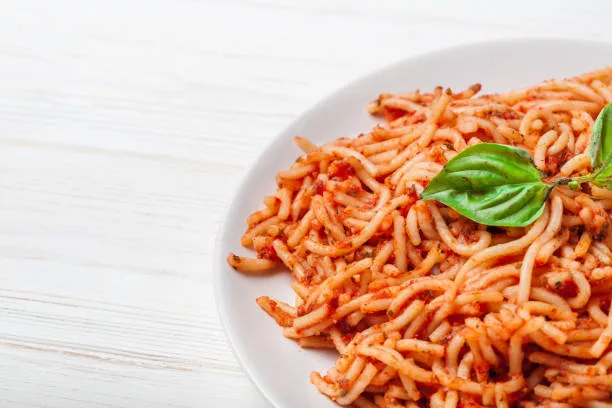
Ingredients:
- Spaghetti
- Red palm oil
- Onions
- Fresh tomatoes or tomato paste
- Red bell peppers
- Scotch bonnet peppers (for those who enjoy some heat)
- Seasonings and spices (e.g., thyme, curry powder, stock cubes, and salt)
- Protein source (optional, e.g., chicken, shrimp, or vegetables)
Preparation:
- Cook the Spaghetti: Start by cooking the spaghetti according to the package instructions. Drain and set it aside.
- Prepare the Jollof Sauce: In a separate pot, heat red palm oil until it becomes clear but not overheated. Add chopped onions and allow them to sauté for a few minutes.
- Blend the Pepper Mix: In a blender, combine fresh tomatoes, red bell peppers, and Scotch bonnet peppers. Blend until you have a smooth paste.
- Cook the Pepper Mix: Add the blended pepper mix to the pot with the palm oil and onions. Let it simmer and cook down until the oil starts to separate from the pepper, and the mixture thickens.
- Add Seasonings: Season the pepper mix with thyme, curry powder, stock cubes, and salt to taste.
- Incorporate the Spaghetti: Gently add the cooked spaghetti to the pot with the Jollof sauce. Stir well to ensure the spaghetti is coated with the flavorful sauce.
- Add Protein (Optional): If desired, you can add your choice of protein sources, such as chicken, shrimp, or vegetables. Ensure they are cooked through and well incorporated into the dish.
- Simmer and Serve: Let the Jollof Spaghetti simmer for a few minutes to ensure all the flavors meld together. It’s typically served hot and can be enjoyed as a standalone dish or with a side of vegetable salad.
Health Benefits for Diabetics:
Jollof Spaghetti offers several health benefits for individuals managing diabetes:
- Balanced Carbohydrates: While spaghetti is a source of carbohydrates when combined with the spicy Jollof sauce, it can be a well-balanced meal that allows for portion control.
- Spices and Flavors: The use of spices like Scotch bonnet peppers can aid in metabolism and weight management, which are essential aspects of diabetes control.
- Customizable: Jollof Spaghetti can be customized to suit your preferences and dietary needs, allowing for greater control over your food choices.
Jollof Spaghetti is a tasty and diabetes-friendly take on a beloved Nigerian classic. When prepared with care and portion control, it can be a satisfying and flavorful part of your culinary journey while keeping your blood sugar levels in check. Enjoy its savory and spicy taste while prioritizing your health.
17. Spinach and Egg Sauce:
A Healthy and Diabetes-Friendly Nigerian Delight
Spinach and Egg Sauce is a wholesome and nutritious Nigerian dish that’s both flavorful and suitable for individuals managing diabetes. This dish combines vibrant spinach leaves and protein-rich eggs to create a satisfying and balanced meal.

Ingredients:
- Fresh spinach leaves
- Eggs
- Onions
- Red bell peppers
- Tomatoes
- Fresh pepper (Scotch bonnet or habanero, depending on spice preference)
- Cooking oil (such as vegetable oil)
- Seasonings and spices (e.g., thyme, stock cubes, salt, and black pepper)
Preparation:
- Prepare the Spinach: Wash the fresh spinach leaves thoroughly and chop them into bite-sized pieces.
- Scramble the Eggs: In a separate bowl, beat the eggs and set them aside.
- Prepare the Pepper Mix: In a blender, combine red bell peppers, tomatoes, and fresh pepper (Scotch bonnet or habanero) to create a smooth paste.
- Cook the Sauce: In a pot, heat cooking oil and sauté chopped onions until translucent. Add the pepper mix and allow it to simmer and cook down until the oil starts to separate from the pepper, and the mixture thickens.
- Add Seasonings: Season the sauce with thyme, stock cubes, salt, and black pepper to taste.
- Incorporate Spinach and Eggs: Gently add the chopped spinach leaves to the pot with the sauce and stir well to wilt them. Once the spinach has wilted, pour the beaten eggs into the pot and stir until the eggs are cooked and well combined with the sauce.
- Simmer and Serve: Allow the Spinach and Egg Sauce to simmer for a short while to let the flavors meld together. It’s typically served hot and can be enjoyed on its own or with a side of whole-grain rice or fufu.
Health Benefits for Diabetics:
Spinach and Egg Sauce offers several health benefits for individuals managing diabetes:
- Low in Carbohydrates: This dish is naturally low in carbohydrates, making it an excellent choice for diabetes management.
- Rich in Protein: The combination of eggs and spinach provides a healthy dose of protein, which can help regulate blood sugar levels and promote satiety.
- Nutrient-Rich: Spinach is rich in essential nutrients, including vitamins, minerals, and antioxidants, contributing to overall health.
Spinach and Egg Sauce is a healthy and diabetes-friendly option that allows you to enjoy the flavors of Nigeria while maintaining control over your blood sugar levels. It’s a nutritious and balanced meal that can be a delightful part of your culinary journey.
18. Catfish Pepper Soup:
A Spicy and Diabetes-Friendly Nigerian Delicacy
Catfish Pepper Soup, also known as “Point and Kill,” is a tantalizing and aromatic Nigerian dish known for its bold and spicy flavors. While it packs some heat, this dish offers a delightful combination of catfish and a fragrant pepper soup broth.

Ingredients:
- Catfish (fresh or frozen)
- Onions
- Fresh pepper (Scotch bonnet or habanero, depending on spice preference)
- Tomatoes
- Ginger
- Garlic
- Seasonings and spices (e.g., thyme, scent leaves, uziza leaves, stock cubes, and salt)
- Lemongrass (optional)
- Uda seeds (optional, for a smoky flavor)
- Water or fish broth
Preparation:
- Prepare the Catfish: Clean and gut the catfish thoroughly. You can also have your fishmonger do this for you.
- Prepare the Pepper Soup Broth: In a pot, combine chopped onions, fresh pepper, tomatoes, ginger, and garlic. Add water or fish broth to create a flavorful base.
- Season the Broth: Season the broth with thyme, stock cubes, and a pinch of salt. You can also add lemongrass and uda seeds for extra flavor.
- Simmer the Broth: Allow the broth to simmer and cook down, letting the flavors meld together.
- Add the Catfish: Gently add the cleaned catfish to the simmering broth. Let the catfish cook until it’s tender and flakes easily.
- Incorporate Seasonings and Aromatics: Add chopped scent leaves and uziza leaves to the pot for an aromatic burst. Adjust the spice level to your preference by adding more Scotch bonnet or habanero pepper if desired.
- Simmer and Serve: Allow the Catfish Pepper Soup to simmer for a short while to let the flavors meld together. It’s typically served hot and can be accompanied by a side of whole-grain rice or fufu.
Health Benefits for Diabetics:
Catfish Pepper Soup offers several health benefits for individuals managing diabetes:
- Lean Protein: Catfish is a source of lean protein, which can help regulate blood sugar levels and promote satiety.
- Spices and Flavors: The use of spices and aromatic herbs in this dish can aid in metabolism and weight management, which are essential aspects of diabetes control.
- Customizable: Catfish Pepper Soup can be customized to suit your preferences and dietary needs, allowing for greater control over your food choices.
Catfish Pepper Soup is a spicy and aromatic delight in Nigerian cuisine. While it can be quite spicy, it’s a flavorful addition to your culinary journey, especially when enjoyed in moderation and alongside other balanced dishes suitable for diabetes management. Enjoy its bold and fiery taste while prioritizing your health.
19. Suya:
A Flavorful and Diabetes-Friendly Nigerian Treat
Suya is a beloved Nigerian street food that’s cherished for its bold flavors and tantalizing taste. While it’s known for its spiciness, it can still be enjoyed in a diabetes-friendly manner by making some mindful choices.

Ingredients:
- Skewered meat (common choices include beef, chicken, or goat)
- Suya spice mix (a combination of ground peanuts, chili peppers, ginger, garlic, and other seasonings)
- Onions
- Sliced tomatoes and cucumber (for garnish)
- Suya sauce (often made with peanut butter, soy sauce, and spices)
- Wooden skewers for grilling
Preparation:
- Marinate the Meat: Start by marinating your choice of meat with the suya spice mix. This adds a burst of flavor and spiciness. You can adjust the spice level to your preference.
- Skewer the Meat: Thread the marinated meat onto wooden skewers, ensuring that the meat pieces are evenly spaced.
- Grill the Suya: Heat a grill to medium-high heat and place the skewers on it. Grill the meat until it’s cooked to your desired level of doneness, turning the skewers as needed.
- Prepare the Garnishes: While the meat is grilling, slice onions, tomatoes, and cucumber to use as garnishes.
- Serve Hot: Once the suya is grilled to perfection, remove it from the skewers and serve hot. You can drizzle suya sauce over the meat and garnish with the sliced vegetables.
Health Benefits for Diabetics:
Suya can be enjoyed in a diabetes-friendly way by considering the following:
- Portion Control: Mindful portion control is key when enjoying suya. Avoid overindulging and monitor your carbohydrate intake.
- Lean Protein: Opt for lean meat choices like chicken or beef, and trim excess fat before marinating and grilling.
- Spice Level: Adjust the spice level to your preference, and be cautious with the peanut sauce, which can be high in sugar. Consider using a sugar-free or reduced-sugar alternative for the sauce.
Suya is a flavorful and satisfying part of Nigerian cuisine. While it can be spicy and bold, with thoughtful choices, it can still be enjoyed as a treat for individuals managing diabetes. Relish its savory and smoky flavors while keeping your blood sugar levels in check.
20. Cauliflower Fried Rice:
A Healthy and Diabetes-Friendly Twist on a Classic
Cauliflower Fried Rice is a nutritious and low-carb adaptation of the traditional Nigerian Fried Rice. It’s a flavorful and diabetes-friendly dish that swaps out rice for cauliflower, making it a suitable choice for those looking to manage their blood sugar levels.

Ingredients:
- Cauliflower florets (riced cauliflower)
- Cooking oil (e.g., vegetable oil)
- Onions
- Mixed vegetables (e.g., carrots, peas, and bell peppers)
- Eggs
- Protein source (e.g., chicken, shrimp, or tofu)
- Soy sauce (use a low-sodium version if preferred)
- Seasonings and spices (e.g., garlic, ginger, stock cubes, salt, and black pepper)
- Sliced green onions (for garnish)
Preparation:
- Prepare the Cauliflower Rice: Use a food processor or a box grater to grate or pulse cauliflower florets into rice-sized pieces. You can also purchase pre-riced cauliflower for convenience.
- Cook the Protein: In a large pan or wok, heat a bit of cooking oil and cook your choice of protein (chicken, shrimp, or tofu) until it’s fully cooked. Set it aside.
- Sauté Onions and Garlic: In the same pan, add a bit more oil and sauté chopped onions and minced garlic until they become fragrant.
- Add Vegetables: Stir in the mixed vegetables (carrots, peas, bell peppers, etc.) and cook until they are tender yet crisp.
- Push Vegetables to the Side: Push the cooked vegetables to one side of the pan and crack eggs into the other side. Scramble the eggs until they are fully cooked.
- Incorporate Cauliflower Rice: Add the riced cauliflower to the pan and stir well to combine it with the cooked vegetables and eggs.
- Season with Soy Sauce: Drizzle soy sauce over the cauliflower mixture and stir to distribute the flavor.
- Season to Taste: Season the Cauliflower Fried Rice with stock cubes, salt, black pepper, and any additional seasonings to your liking.
- Add Cooked Protein: Gently fold in the cooked protein (chicken, shrimp, or tofu) to the Cauliflower Fried Rice and stir to warm it.
- Garnish with Green Onions: Sprinkle sliced green onions over the dish for a fresh garnish.
- Serve Hot: Cauliflower Fried Rice is best served hot and can be enjoyed as a flavorful and low-carb alternative to traditional fried rice.
Health Benefits for Diabetics:
Cauliflower Fried Rice offers several health benefits for individuals managing diabetes:
- Low in Carbohydrates: By using cauliflower instead of rice, this dish is naturally low in carbohydrates, making it an excellent choice for diabetes management.
- Balanced Nutrition: The inclusion of vegetables, protein, and healthy fats in this dish provides balanced nutrition while helping regulate blood sugar levels.
- Versatility: Cauliflower Fried Rice can be customized with your choice of protein and vegetables, allowing you to create a variety of delicious and diabetes-friendly meals.
Cauliflower Fried Rice is a healthy and diabetes-friendly twist on a classic Nigerian dish. It allows you to savor the rich flavors of fried rice while making mindful choices to support your health and blood sugar management. Enjoy its wholesome and savory taste as part of your culinary journey.
These 20 Nigerian dishes offer a world of flavors and health benefits without the added sugars that can disrupt blood sugar levels. They’re not only delicious but also ideal for individuals with diabetes looking to maintain a balanced and enjoyable diet.
Remember, while these dishes are naturally low in sugar, it’s important to manage portion sizes and monitor your carbohydrate intake. If you have specific dietary requirements or health concerns, it’s advisable to consult with a healthcare professional or a registered dietitian for personalized guidance.
In conclusion, diabetes doesn’t mean you have to sacrifice the joys of Nigerian cuisine. With these 20 sugar-free options, you can savor the flavors of Nigeria while taking care of your health. So go ahead, enjoy your meal, and embark on a journey of delicious and diabetic-friendly dining.











